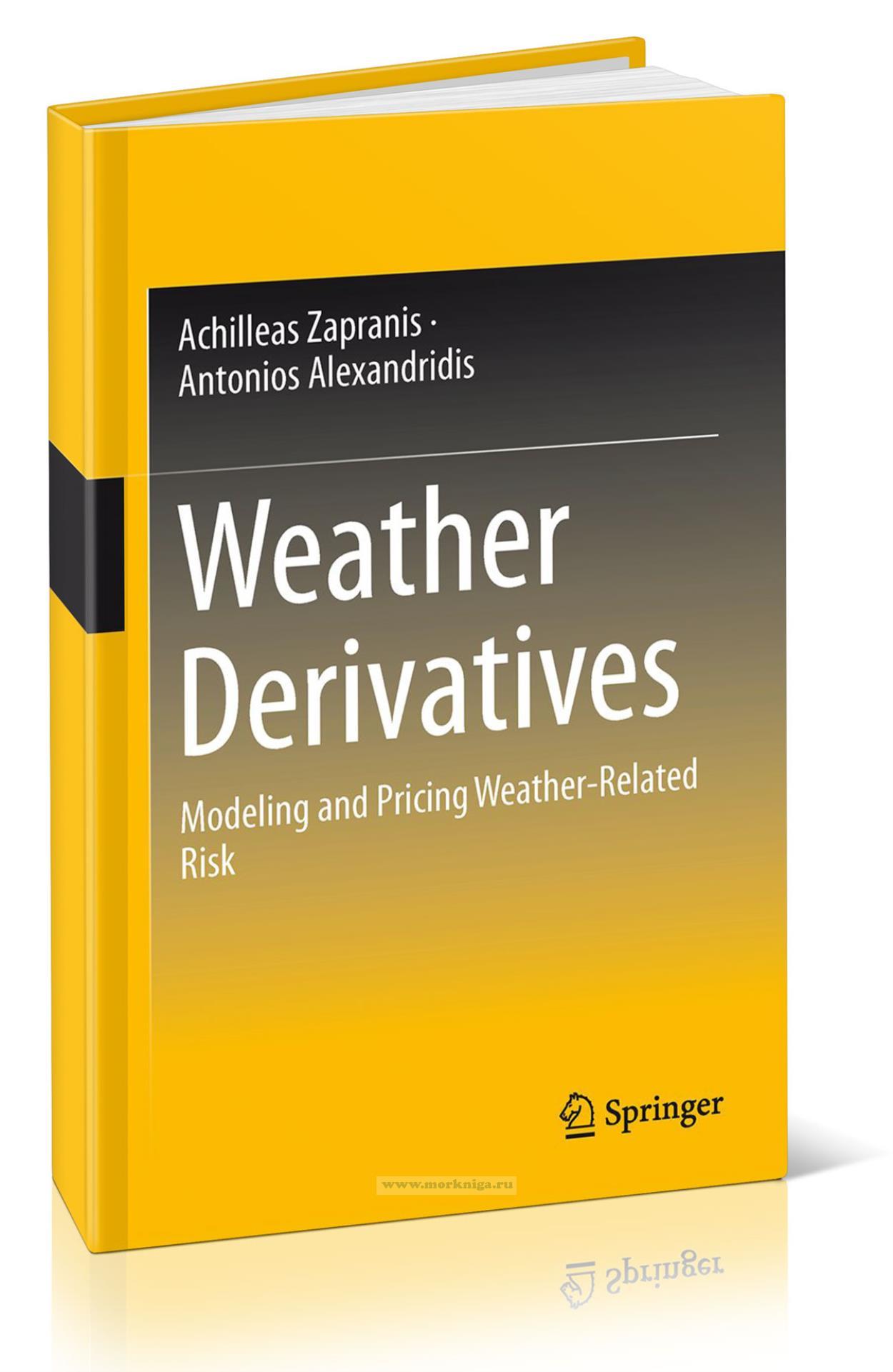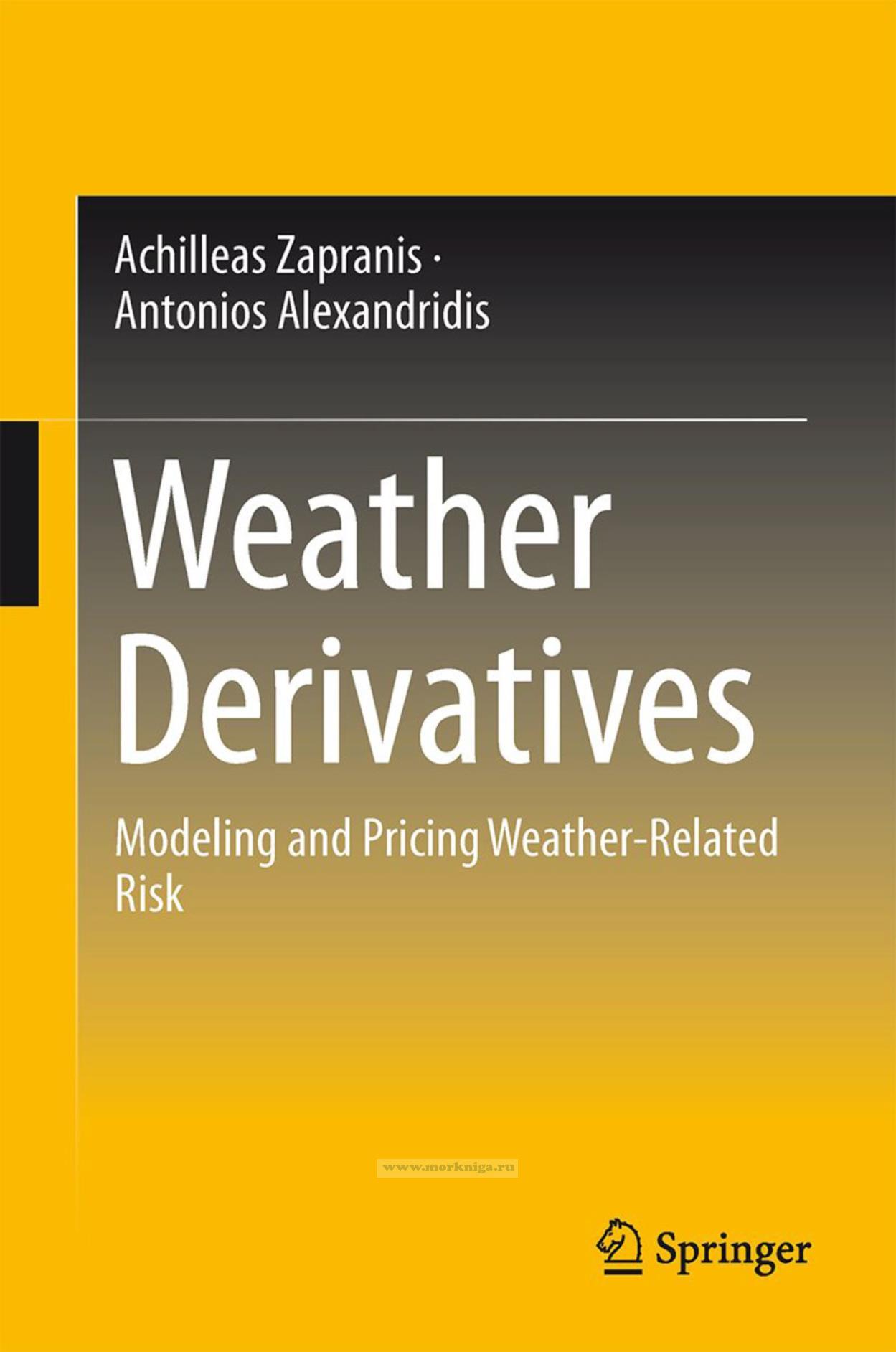Weather Derivatives- Modelling and Pricing Weather Related Risk/–Я–Њ–≥–Њ–і–љ—Л–µ –њ—А–Њ–Є–Ј–≤–Њ–і–љ—Л–µ. –Ь–Њ–і–µ–ї–Є—А–Њ–≤–∞–љ–Є–µ –Є —Ж–µ–љ–∞ —А–Є—Б–Ї–∞, —Б–≤—П–Ј–∞–љ–љ–∞—П —Б –њ–Њ–≥–Њ–і–Њ–є
–Ъ–љ–Є–≥–∞ –љ–∞ –∞–љ–≥–ї–Є–є—Б–Ї–Њ–Љ —П–Ј—Л–Ї–µ
Weather derivatives are financial instruments that can be used by organizations or individuals as part of a risk management strategy to minimize risk associated with adverse or unexpected weather conditions. Just as traditional contingent claims, a weather derivative has an underlying measure, such as: rainfall, wind, snow or temperature. Nearly $1 trillion of the U.S. economy is directly exposed to weather-related risk. More precisely, almost 30% of the U.S. economy and 70% of U.S. companies are affected by weather. The purpose of this monograph is to conduct an in-depth analysis of financial products that are traded in the weather market. Presenting a pricing and modeling approach for weather derivatives written on various underlying weather variables will help students, researchers, and industry professionals accurately price weather derivatives, and will provide strategies for effectively hedging against weather-related risk. This book will link the mathematical aspects of the modeling procedure of weather variables to the financial markets and the pricing of weather derivatives. Very little has been published in the area of weather risk, and this volume will appeal to graduate-level students and researchers studying financial mathematics, risk management, or energy finance, in addition to investors and professionals within the financial services industry.
Contents
1 The Weather Derivatives Market
1.1 Introduction
1.2 The Weather Market
1.2.1 The Purpose of Weather Derivatives
1.2.2 The Weather Market History
1.2.3 Market Participants
1.2.4 Weather Securities
1.2.5 Weather Derivatives and Insurance
1.2.6 Basis Risk
1.3 Weather Derivatives and Related Markets
1.3.1 The Electricity Market
1.3.2 The Oil and Gas Market
1.4 Weather Derivatives Pricing and Other Issues
1.5 Purpose of the Book and Readership Level
1.6 Overview of the Book
References
2 Introduction to Stochastic Calculus
2.1 Introduction
2.2 Some Stochastic Processes
2.3 Ito Integral
2.4 Ito Formula
2.5 Applications of Ito Formula
2.6 GirsanovвАЩs Theorem
2.7 Esscher Transform
2.8 Conclusions
References
3 Handling the Data
3.1 Introduction
3.2 Data Cleaning and Preprocessing
3.2.1 Missing Values
3.2.2 Erroneous Values
3.2.3 Jump and Discontinuities Detection
3.3 Identifying and Removing Trends
3.3.1 Reasons of Trends
3.3.2 Structures of Trends
3.4 Identifying and Removing Seasonalities
3.5 El Nino and La Nina Effects
3.6 Selection of the Length of Historical Data
3.7 Conclusions
References
4 Pricing Approaches of Temperature Derivatives
4.1 Introduction
4.2 Actuarial Method
4.3 Historical Burn Analysis
4.4 Index Modeling
4.5 Daily Modeling
4.5.1 Discrete Process
4.5.2 Continuous Process
4.6 Alternative Methods
4.7 Conclusions
References
5 Modeling the Daily Average Temperature
5.1 Introduction
5.2 Data Description
5.3 Statistical Modeling of Daily Average Temperature
5.4 The Seasonal Mean
5.4.1 The Linear Approach
5.4.2 A More Advanced Approach: Wavelet Analysis
5.5 The Speed of Mean Reversion
5.5.1 The Linear Approach
5.5.2 A More Advanced Approach: The Nonlinear
Nonparametric Approach
5.6 The Seasonal Variance
5.7 Examination of the Residuals
5.7.1 Testing the Normality Hypothesis
5.7.2 In-Sample Comparison
5.7.3 Testing Alternative Distributions for the Residuals
5.8 The Forecasting Ability of the Daily Models
5.9 Conclusions
References
6 Pricing Temperature Derivatives
6.1 Introduction
6.2 Temperature Derivatives Traded in the CME
6.3 Solving the Temperature Stochastic Differential Equation
6.4 Pricing Under the Normal Assumption
6.4.1 CAT and Pacific Rim: Futures and Options
6.4.2 HDD and CDD Indices: Futures and Options
6.5 Pricing Under the Assumption of a Levy Noise Process
6.6 The Market Price of Risk
6.7 Conclusions
References
7 Using Meteorological Forecasts for Improving Weather Derivative
Pricing
7.1 Introduction
7.2 Numerical Weather Prediction
7.3 Ensemble Forecasts
7.4 Probabilistic Forecasts and Scenario Analysis
7.5 Meteorological Forecasts and Pricing
7.6 Conclusions
References
8 The Effects of the Geographical and Basis Risk
8.1 Introduction
8.2 Weather Risk Management and the Geographical/Spatial Risk
8.2.1 A Spatial Model for Temperature
8.3 Weather Risk Management and the Basis Risk
8.4 Conclusions
References
9 Pricing the Power of Wind
9.1 Introduction
9.2 Modeling the Daily Average Wind Speed
9.2.1 The Linear ARMA Model
9.2.2 Wavelet Networks for Wind Speed Modeling
9.2.3 Forecasting Daily Average Wind Speeds
9.3 Pricing Wind Derivatives
9.3.1 The Cumulative Average Wind Speed Index
9.3.2 The Nordix Wind Speed Index
9.4 Conclusions
References
10 Precipitation Derivatives
10.1 Introduction
10.2 Precipitation Modeling
10.2.1 Annual Rainfall
10.2.2 Monthly Rainfall
10.2.3 Daily Rainfall
10.3 A Daily Rainfall Process
10.3.1 Frequency Modeling
10.3.2 Magnitude Modeling
10.4 Pricing Precipitation Derivatives
10.4.1 Indifference Pricing for Rainfall Derivatives
10.4.2 Limitations of Indifference Pricing Method
10.4.3 Hedging Effectiveness
10.4.4 Monte Carlo Simulation
10.5 Conclusions
References
Appendix A
Appendix B
Index

